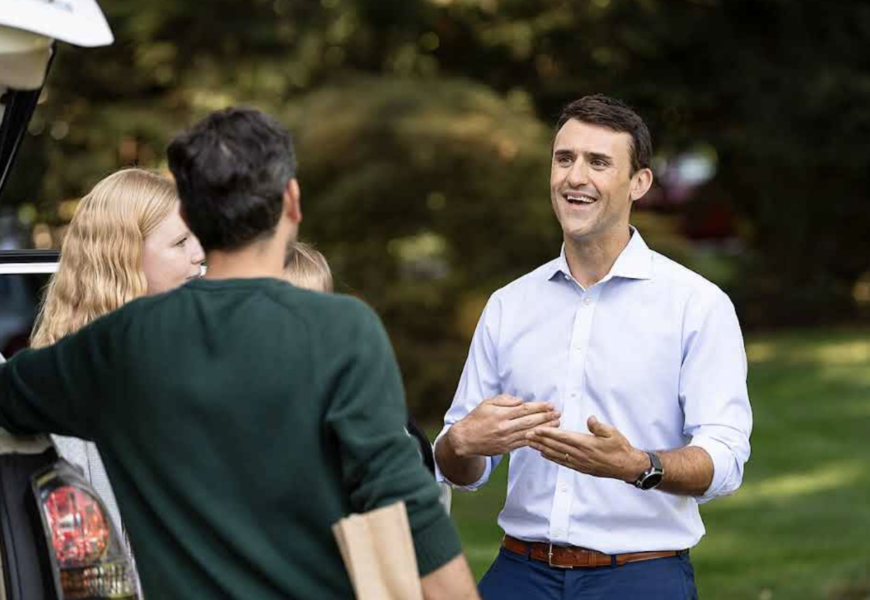Courtesy of Nick Simmons Campaign
This week I had the opportunity to interview Connecticut State Senate Candidate Nick Simmons. At just 35, Nick Simmons has already carved out a name for himself as a dynamic and driven leader. Hailing from Greenwich, Simmons’ journey began in the classroom, where he taught in Harlem and became one of New York City’s youngest acting principals by the age of 26. His passion for education and public policy led him to roles advising Connecticut Governor Ned Lamont and serving in the Biden administration as senior advisor to the U.S. secretary of education. Now, Simmons is channeling his experience and energy into his campaign for Connecticut’s 36th District Senate. As a millennial candidate with a track record of bipartisan cooperation and community-focused solutions, Simmons represents a new generation of leadership for Connecticut.
Tara Kamen: You’re running in a particularly partisan time. What challenges do you face while campaigning in such a divided political landscape?
Nick Simmons: My district, which includes the towns of Greenwich, North Stamford, and New Canaan, has a fascinating political history. For many years, it was a Republican stronghold, often voting in line with conservative values. However, since Donald Trump’s election in 2016, we’ve seen a significant shift in the political climate. Like many suburban areas nationwide, voters here have grown increasingly uncomfortable with the extremism that has emerged from the MAGA movement, particularly the stances on immigration and women’s rights.
The biggest shift has been among unaffiliated voters, who now represent about 40% of the district. Many of them feel disillusioned by the hyper-partisanship they see, especially on the far right. As I campaign, my focus is on addressing that disillusionment by offering a vision of returning to civility and constructive dialogue. I often draw on the legacy of George H.W. Bush, who was born here, and represented a time when politics was more civil. I’m a proud Democrat, but I know that many people miss the days when leaders worked across the aisle for the common good. It’s about reminding voters that there’s a way forward that prioritizes practical solutions over divisive rhetoric.
TK: You started as a teacher in Harlem and became one of New York’s youngest acting principals at 26. What inspired your transition from education to politics?
NS: Teaching in Harlem was the most formative experience of my life. I worked with some of the most incredible, resilient young people who faced enormous challenges every day. Many of my students came from single-parent households, dealt with homelessness, hunger, and even abuse. These weren’t just stories—they were real, pressing issues my students lived through every day. I remember vividly the efforts we made to not just teach them math but to create a school that supported them holistically. We extended the school day to accommodate parents’ work schedules, helped families find housing and childcare, and ensured students had access to healthy meals.
One of the most inspiring moments of my career was watching these students grow. I remember one student, Mokhtar, who had been homeless when I first met him. Years later, I helped him move into his dorm at MIT. That experience, and many like it, showed me what is possible when you give people the tools and support they need. It also underscored the importance of setting high expectations for our communities. Too often, we set the bar too low, and in doing so, we limit the potential of individuals and communities. That experience drove me to want to work on a larger scale, to use public policy to create systemic changes that help all communities thrive. It’s what brought me into government, first working for Governor Lamont and then for the Biden administration, so I could help shape policies that improve people’s lives.
TK: You worked for Governor Lamont and served as a Senior Advisor to the Secretary of Education in the Biden Administration. How has that shaped your perspective on state politics?
NS: Working in Governor Lamont’s office gave me an inside look at how state government operates and how policies get turned into action—or sometimes, how bureaucracy can slow that process down. One of the key things I worked on was building Connecticut’s Office of Workforce Strategy. We created a team that focused on aligning our K-12 education system and community colleges with workforce needs. It was all about making sure students were prepared for the jobs of today and tomorrow, and ensuring that employers could find the talent they needed within our state.
I also worked on economic development initiatives aimed at revitalizing cities like Bridgeport and Stamford. We cleared out old industrial areas to make room for new housing and businesses. These efforts were about more than just buildings—they were about improving the quality of life for residents and creating economic opportunities.
During COVID-19, my role took on a whole new dimension when I was called to serve as Senior Advisor to the Secretary of Education for school reopening and recovery. We were faced with unprecedented challenges as schools across the country had to quickly pivot to remote learning. We knew that students, especially in lower-income communities, were falling behind academically and suffering emotionally from the isolation. Our job was to figure out how to safely reopen schools and get students back into classrooms while ensuring their mental and physical health was prioritized. This experience showed me just how crucial it is for government policies to be nimble and responsive, especially during crises. It reinforced my belief that legislators need to set clear, empowering priorities for state agencies, so they can effectively implement policies that make a real difference in people’s lives.
TK: How has the pandemic influenced your priorities?
NS: The pandemic brought to light a lot of issues that had been simmering under the surface, but it also created entirely new challenges, particularly for young people. One of the biggest takeaways for me was the immense strain the pandemic placed on students’ mental health. We saw skyrocketing rates of anxiety, depression, and even suicidal thoughts among young people. The data we collected during that time was staggering—absenteeism rates in Connecticut schools shot up to 25-27%, and many students were completely disconnected from their school communities.
For lower-income families, the challenges were even more pronounced. Many students didn’t have reliable internet or access to a computer, making remote learning nearly impossible. We were seeing huge learning losses, but beyond that, the emotional toll of being isolated from peers and teachers was devastating. For many of these students, school was more than just a place to learn—it was a safe space, a source of stability. Rebuilding that sense of community and addressing the mental health crisis among young people has become a top priority for me. It’s not something that will be fixed overnight, but it’s critical that we continue to invest in resources that support the whole student—academically, emotionally, and socially.
TK: Across the country the housing costs are rising. What are your plans to address affordable housing here in Connecticut?
NS: Housing affordability is one of the biggest challenges facing Connecticut today. In my time working for Governor Lamont, we allocated $800 million in the 2023 budget to address the housing shortage. The reality is that Connecticut has built very little new housing in the last decade. In fact, we ranked second-to-last in new housing construction across the entire country. This lack of new housing is a big part of why prices are skyrocketing, particularly in urban areas.
I fully support the governor’s approach to using state funds to incentivize new housing construction, both affordable housing and what we call workforce housing, which is targeted at middle-income earners. It’s not just about building new homes, though—it’s about smart development that revitalizes communities. We’ve worked on clearing old industrial lots to create spaces for new housing, and those kinds of projects will continue to be crucial.
Housing isn’t just a social issue; it’s also an economic one. When businesses look at Connecticut, one of their biggest concerns is whether their workers can afford to live here. Companies have told us point-blank that they’ve chosen to set up shop in other states, like Texas, because housing costs are lower. So, addressing the affordable housing crisis isn’t just about helping individuals and families—it’s about ensuring Connecticut remains competitive economically.
TK: As a young candidate, how do you plan to increase civic engagement among young people?
NS: One of the most inspiring things I’ve seen during this campaign is the incredible energy from young people. They’re passionate, engaged, and ready to take action, but we need to ensure that they understand just how much is at stake. My opponent is a prime example—he won his last election by just 80 votes. That razor-thin margin allowed him to become one of the most right-wing senators in the state, voting to prosecute women who get abortions and attempting to derail Connecticut’s gun safety laws.
When I talk to young people, I emphasize that every vote matters. Every phone call, every door knock could be the difference in an election. I’ve seen firsthand the impact that youth activism can have—take the Newtown Youth Alliance, for example. These are young people who survived the Sandy Hook shooting as children, and now they’re some of the fiercest advocates for gun safety laws in the country. Seeing their dedication is a reminder of the power young people have when they get involved. It’s not just about voting—it’s about becoming an active participant in shaping the future. I think the more we can show young people that their voices truly matter, the more we’ll see them stepping up.
TK: How can people get involved in your campaign?
NS: We need all the help we can get! Volunteers are the backbone of any campaign, and there are plenty of ways to get involved. You can sign up to make phone calls or knock on doors through our website, NickSimmonsForCT.com. What’s great is that you can phone bank from anywhere in the world. We’ll provide you with a call list, and I’ve found that voters love hearing from passionate volunteers, whether they’re calling from Connecticut or even across the globe.
If you’re local, we’d love to have you join us for canvassing. We’re based right off I-95, so it’s easy to get to us. We’ve got amazing people coming out to support, including Treasurer Eric Russell, Governor Lamont, Senator Chris Murphy, and Congressman Himes. It’s a fun, community-driven effort, and we’re always eager to hear from volunteers about what issues matter most to them. Your involvement can make a huge difference, especially in a close race like this one.









